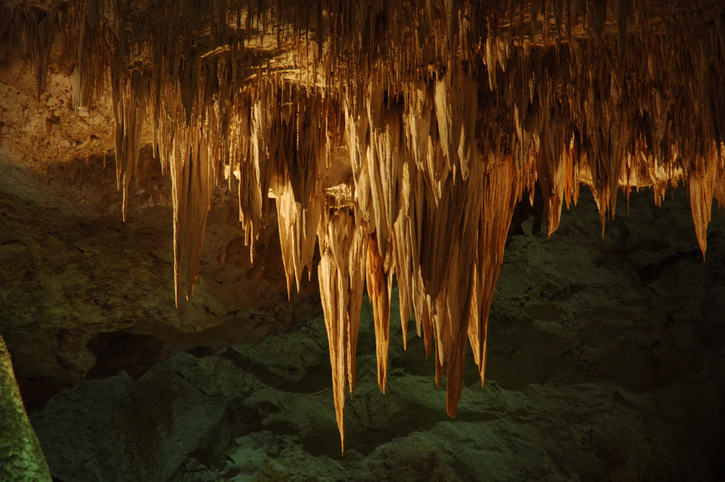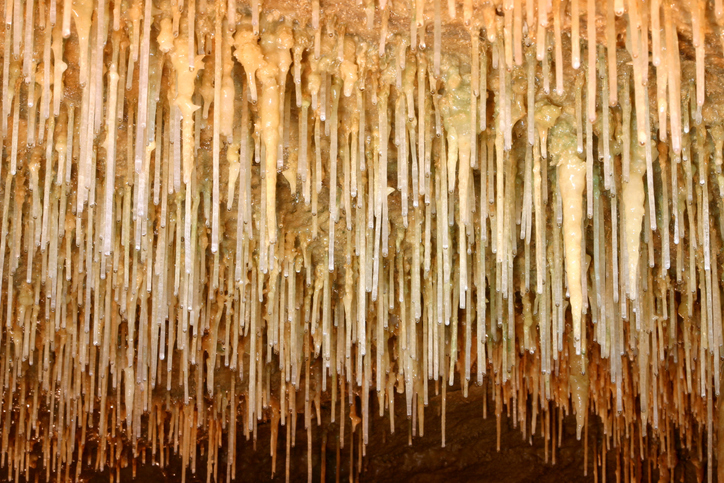Cave Formations
Flowstones
Flowstones are composed of sheetlike deposits of calcite formed where water flows down the walls or along the floors of a cave. They are typically found in “solution caves”, in limestone, where they are the most common speleothem. However, they may form in any type of cave where water enters that has picked up dissolved minerals. Flowstones are formed via the degassing of vadose percolation waters.
Stalactite
A stalactite (from the Greek stalasso, “to drip”, meaning “that which drips”) is a type of formation that hangs from the ceiling of caves, hot springs, or manmade structures such as bridges and mines. Any material which is soluble can be deposited as a colloid or is in suspension, or is capable of being melted, and may form a stalactite. Stalactites may be composed of amberat, lava, minerals, mud, peat, pitch, sand, and sinter. A stalactite is not necessarily a speleothem, though speleothems are the most common form of stalactite because of the abundance of limestone caves.
Stalagmite
A stalagmite (from the Greek stalagmias, “dropping, trickling”) is a type of rock formation that rises from the floor of a cave due to the accumulation of material deposited on the floor from ceiling drippings.
Helictite
A helictite is a speleothem found in limestone caves that changes its axis from the vertical at one or more stages during its growth. They have a curving or angular form that looks as if they were grown in zero gravity. They are most likely the result of capillary forces acting on tiny water droplets, a force often strong enough at this scale to defy gravity.
Helictites are, perhaps, the most delicate of cave formations. They are usually made of needle-form calcite and aragonite. Forms of helictites have been described in several types: ribbon helictites, saws, rods, butterflies, “hands”, curly fries, and “clumps of worms.” They typically have radial symmetry. They can be easily crushed or broken by the slightest touch. Because of this, helictites are rarely seen within arm’s reach in tourist caves.
Soda Straw
A soda straw (or simply straw) is a speleothem in the form of a hollow mineral cylindrical tube. They are also known as tubular stalactites. Soda straws grow in places where water leaches slowly through cracks in the rock, such as on the roofs of caves. A soda straw can turn into a stalactite if the hole at the bottom is blocked, or if the water begins flowing on the outside surface of the hollow tube. These tubes form when calcium carbonate or calcium sulfate dissolved in the water comes out of the solution and is deposited. In soda straws, as each drop hovers at the tip, it deposits a ring of minerals at its edge. It then falls and a new drop takes its place. Each successive drop of water deposits a little more mineral before falling, and eventually a tube is built up. Stalagmites or flowstone may form where the water drops hit the cave floor. Soda straws are some of the most fragile of speleothems. Like helictites, they can be easily crushed or broken by the slightest touch. Because of this, soda straws are rarely seen within arms’ reach in show caves or others with unrestricted access. When left alone, soda straws have been known to grow up to 9 meters (30 feet) long.

Educate your Students!
Many caves of the NCA offer educational programs to students, scout troops and more! Contact our Director for a list of caverns that offer these programs.



